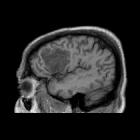diffusion weighted imaging in acute stroke




Diffusion weighted imaging (DWI) is a commonly performed MRI sequence for evaluation of acute ischemic stroke, and is sensitive in the detection of small and early infarcts. Conventional MRI sequences (T1WI, T2WI) may not demonstrate an infarct for 6 hours, and small infarcts may be hard to appreciate on CT for days, especially without the benefit of prior imaging.
Increased DWI signal in ischemic brain tissue is observed within a few minutes after arterial occlusion and progresses through a stereotypic sequence of apparent diffusion coefficient (ADC) reduction, followed by subsequent increase, pseudo-normalization and, finally, permanent elevation. Reported sensitivity ranges from 88-100% and specificity ranges from 86-100%.
For a general discussion of the pathogenesis and radiographic features please refer to ischemic stroke.
Radiographic features
The appearance of DWI/ADC depends on the timing.
Acute (0-7 days)
- ADC value decreases with maximal signal reduction at 1 to 4 days
- marked hyperintensity on DWI (a combination of T2 and diffusion weighting), less hyperintensity on exponential images, and hypointensity on ADC images
- subsequently, release of inflammatory mediators from ischemic brain tissue leads to vasogenic edema with extravasation of water molecules from blood vessels to expand the interstitial space, where water molecule diffusion is highly unrestricted
- early DWI reversal (aka diffusion lesion reversal) can occur, most frequently with reperfusion, but this rarely alters the size of the eventual infarct and is probably a 'pseudoreversal' .
Subacute (1-3 weeks)
- ADC pseudonormalization occurs in the second week (7-15 days)
- ADC values rise and return to near baseline
- irreversible tissue necrosis is present despite normal ADC values
- DWI remains hyperintense due to T2 shine through
- after 2 weeks ADC values continue to rise above normal parenchyma and the region appears hyperintense
Chronic (>3 weeks)
- ADC signal high
- DWI signal low (as T2 hyperintensity and thus T2 shine through resolve)
Siehe auch:
und weiter:

 Assoziationen und Differentialdiagnosen zu diffusion weighted MRI in acute stroke:
Assoziationen und Differentialdiagnosen zu diffusion weighted MRI in acute stroke:

